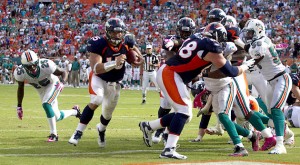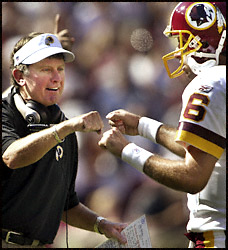Dan Quinn and the Atlanta Falcons pulled off a big upset on Wild Card weekend, winning 26-13 in Los Angeles against the heavily favored Rams. The win was driven in large part by special teams: Atlanta picked up 40 yards of field position on punts, Falcons kicker Matt Bryant was 4/4 on field goals, including from 51 and 54 yards away, and the Rams lost two fumbles on special teams, with one muff and one fumble by Pro Bowler Pharoh Cooper.
Special teams was the story of the game, but the narrative nearly shifted to a monumental mistake by Quinn. With just under 6 minutes left in the game, the Falcons scored a touchdown to take a 25-13 lead. Up by 12 with 5:54 remaining, going for 2 is the obvious choice. The difference between a 12-point lead and a 13-point lead with 6 minutes left isn’t much; meanwhile, the difference between a 13-point lead and a 14-point lead is huge. The Rams were very unlikely to have three possessions left and to tie the game with a touchdown and two field goals, but a Los Angeles touchdown, followed by a stop, followed by another Rams TD was certainly on the table. That would win the game if the Rams were down 12 or 13, but only force overtime if the Rams were down by 14.
Yet, remarkably, Quinn chose to kick the extra point. Since the start of the 2012 season, there had been 12 instances where a team scored a touchdown to take a 12-point lead with less than 7 minutes left in the game. Even overly conservative coaches mostly got this right: they went for two in 9 of 12 cases.
The three exceptions were notable:
In week 2 of the 2016 season, the Jets took a 36-24 lead over the Bills with just over four minutes remaining. I tweeted that the Jets needed to go for 2 after scoring, was incredulous after they did not, and then hoped the Jets media would ask Bowles about it after the game. It turns out that they did, and Bowles admitted making a mistake.
Bowles on Friday said he “should’ve” gone for two in this spot. Why didn’t he?
“I was occupied doing something with the defense,” he said. “When I turned around and looked at it, that was my bust. I’ll be better going forward.”
Another example came in 2013, when (at the time) everyone’s favorite coach, Chuck Pagano, pulled off a big upset but made this same mistake. I wrote about that at the time, too:
I can’t believe I’m writing this article. Everyone loves Chuck Pagano, but he made a pretty embarrassing blunder at the end of the Colts upset win in San Francisco on Sunday. The Colts led 13-7 when Andrew Luck scrambled for a six yard touchdown on 3rd-and-3 with just over four minutes left in the fourth quarter. Incredibly, Pagano then chose to kick the extra point, which my buddy and Colts fan Nate Dunlevy identified immediately as a terrible decision.
I wasn’t going to write a post about that decision, because, ya know, what could be more obvious than going for two when up by 12 points with just over four minutes left in the game? I mean, Jason Garrett got this right in the season opener. Being up by 14 points means two touchdowns doesn’t beat you, while there is almost no difference between being up 12 or being up 13 points.
The final example involved the Browns in a 37-24 win over Buffalo. Cleveland recorded a pick six with just under two minutes left to take a 36-24 lead. Maybe Rob Chudzinski was so surprised by the score that he simply made a brainfart the way Bowles did. In some ways, the mistake was minimized, because the odds of the other team scoring two touchdowns in less than two minutes are much lower than two touchdowns in six minutes. On the other hand, there’s literally no justification at all for not going for two in that case, because the opponent can’t have three possessions. [continue reading…]





